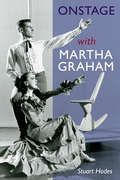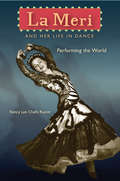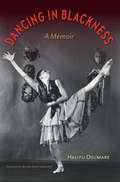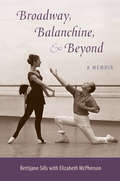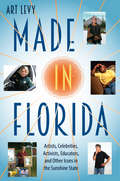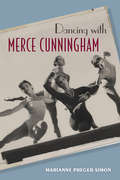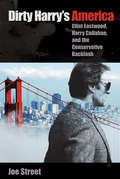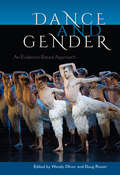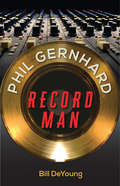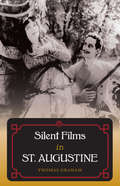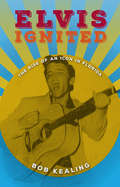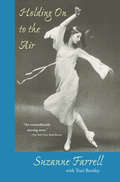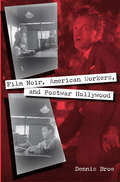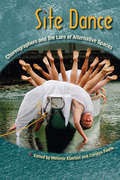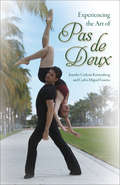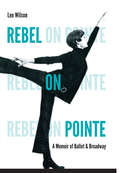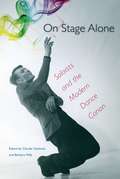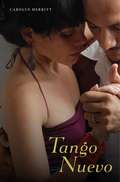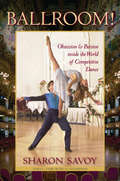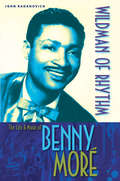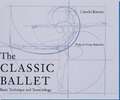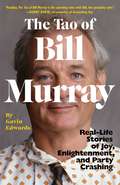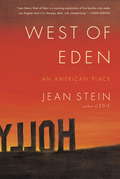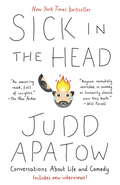- Table View
- List View
Onstage with Martha Graham
by Stuart HodesWhen World War II was over, a young bomber pilot with an itch for movement and action hung up his cap and learned another way to fly. Onstage with Martha Graham is the story of Stuart Hodes, a versatile and influential dancer who got his start with Martha Graham, an icon of modern dance. His memoir is a rare firsthand view of the dance world in the 1940s and through the end of the twentieth century. One of the few male dancers in Graham’s company—and in the New York dance scene at the time—Hodes offers a unique perspective and a one-of-a-kind narrative. He describes how he fell into the art by chance, happening to walk into Graham’s studio one day. He was soon hooked. He documents his experiences, travels, passions, and loves while learning from and performing with Graham, during which time he saw most of the United States, much of Europe, and some of Asia. Advancing quickly, he eventually danced as Graham’s partner in Appalachian Spring, Deaths and Entrances, Every Soul Is a Circus, and Errand into the Maze. In his portrait of Martha Graham, who was the center of his dancing world, Hodes recounts conversations, revelations, bouts of temper and creativity, the daily ritual of deeply physical dancing, and the never-ending search for artistic validity. Direct, often humorous, and always authentic, Hodes shares his delight in dance as both hard work and a fantastic adventure.
La Meri and Her Life in Dance: Performing the World
by Nancy Lee RuyterThis intriguing biography details the life and work of world dance pioneer La Meri (1899–1988). An American dancer, choreographer, teacher, and writer, La Meri was ahead of her time in championing cross-cultural dance performances and education, yet she is almost totally forgotten today. In La Meri and Her Life in Dance, Nancy Ruyter introduces readers to a visionary artist who played a pivotal role in dance history. Born in Texas as Russell Meriwether Hughes, La Meri toured throughout Latin America, Europe, Asia, the Pacific, and the United States in the 1920s and ’30s, immersing herself in different dance traditions at a time when few American dancers explored styles outside their own. She learned about Indian dance culture from the celebrated Uday Shankar, studied belly dancing with the Moroccan sultan’s top dancer, and took flamenco lessons in Spain. La Meri spread awareness and enjoyment of the world’s myriad forms of expression before it was common for performing artists from these countries to tour internationally. Ruyter describes how La Meri founded the Ethnologic Dance Center in New York City, choreographed innovative works based on various dance cultures for Jacob’s Pillow Dance Festival and other venues, and wrote widely on the styles and techniques of international dance genres. This long-overdue book illustrates that the popularity of world dance today owes much to the trailblazing efforts of La Meri.
Dancing in Blackness: A Memoir
by Halifu OsumareDancing in Blackness is a professional dancer's personal journey over four decades, across three continents and 23 countries, and through defining moments in the story of black dance in America. In this memoir, Halifu Osumare reflects on what blackness and dance have meant to her life and international career. Osumare's story begins in 1960s San Francisco amid the Black Arts Movement, black militancy, and hippie counterculture. It was there, she says, that she chose dance as her own revolutionary statement. Osumare describes her experiences as a young black dancer in Europe teaching "jazz ballet" and establishing her own dance company in Copenhagen. Moving to New York City, she danced with the Rod Rodgers Dance Company and took part in integrating the programs at the Lincoln Center. After doing dance fieldwork in Ghana, Osumare returned to California and helped develop Oakland’s black dance scene. Osumare introduces readers to some of the major artistic movers and shakers she collaborated with throughout her career, including Katherine Dunham, Pearl Primus, Jean-Leon Destine, Alvin Ailey, and Donald McKayle. Now a black studies scholar, Osumare uses her extraordinary experiences to reveal the overlooked ways that dance has been a vital tool in the black struggle for recognition, justice, and self-empowerment. Her memoir is the inspiring story of an accomplished dance artist who has boldly developed and proclaimed her identity as a black woman.
Broadway, Balanchine, and Beyond: A Memoir
by Bettijane SillsIn this memoir of a roller-coaster career on the New York stage, former actor and dancer Bettijane Sills offers a highly personal look at the art and practice of George Balanchine, one of ballet’s greatest choreographers, and the inner workings of his world-renowned company during its golden years. Sills recounts her years as a child actor in television and on Broadway, a career choice largely driven by her mother, and describes her transition into pursuing her true passion: dance. She was a student in Balanchine’s School of American Ballet throughout her childhood and teen years, until her dream was achieved. She was invited to join New York City Ballet in 1961 as a member of the corps de ballet and worked her way up to the level of soloist. Winningly honest and intimate, Sills lets readers peek behind the curtains to see a world that most people have never experienced firsthand. She tells stories of taking classes with Balanchine, dancing in the original casts of some of his most iconic productions, working with a number of the company’s most famous dancers, and participating in the company’s first Soviet Union tour during the Cold War and Cuban Missile Crisis. She walks us through her years in New York City Ballet first as a member of the corps de ballet, then a soloist dancing some principal roles, finally as one of the “older” dancers teaching her roles to newcomers while being encouraged to retire. She reveals the unglamorous parts of tour life, jealousy among company members, and Balanchine’s complex relationships with women. She talks about Balanchine’s insistence on thinness in his dancers and her own struggles with dieting. Her fluctuations in weight influenced her roles and Balanchine’s support for her—a cycle that contributed to the end of her dancing career. Now a professor of dance who has educated hundreds of students on Balanchine’s style and legacy, Sills reflects on the highs and lows of a career indelibly influenced by fear of failure and fear of success—by the bright lights of theater and the man who shaped American ballet.
Made in Florida: Artists, Celebrities, Activists, Educators, and Other Icons in the Sunshine State
by Art LevyDiscover some of Florida’s most fascinating personalities in this entertaining kaleidoscope of interviews. Made in Florida showcases a colorful lineup of notable people who got their start in the state and who have helped make it the unique, diverse place it is today. Hear from Carl Hiaasen and Dave Barry about their weirdest writing inspirations. Discover why Shaquille O’Neal never complains. Find out what happens when Burt Reynolds goes to Costco. Listen to Theresa Manuel’s experiences as one of the first black women to compete in the Olympics. Learn about the lives of Seminole Tribe elder Louise Gopher, pop art painter Romero Britto, NASA senior executive JoAnn Morgan, circus daredevil Bello Nock, football coach Steve Spurrier, state CFO Alex Sink, and Muhammad Ali’s “fight doctor” Ferdie Pacheco. In addition to the widely celebrated, Art Levy introduces many unsung individuals. Meet innovative industrialists like “Chainsaw Al” and dedicated naturalists like “The Shark Lady.” Mingle with a legendary rancher, a civil rights historian, and a commercial fisherman. Marvel at an anticrime crusader, a space skydiver, and a snake-venom enthusiast. These and other stars—many of whom rarely give such extensive interviews—talk family and work, joys and worries, failures and triumphs, dislikes and desires. Levy has thoughtfully selected their words from ten years of conversations. Each person tells a different story of Florida from a perspective all their own. Read on and get ready to laugh and lament, to be surprised and inspired.
Dancing with Merce Cunningham
by Marianne Preger-SimonDancing with Merce Cunningham is a buoyant, captivating memoir of a talented dancer’s lifelong friendship with one of the choreographic geniuses of our time. Dancing with Merce Cunningham is a buoyant, captivating memoir of a talented dancer’s lifelong friendship with one of the choreographic geniuses of our time. Marianne Preger-Simon’s story opens amid the explosion of artistic creativity that followed World War II. While immersed in the vibrant arts scene of postwar Paris during a college year abroad, Preger-Simon was so struck by Merce Cunningham’s unconventional dance style that she joined his classes in New York. She soon became an important member of his brand new dance troupe—and a constant friend. Through her experiences in the Merce Cunningham Dance Company, Preger-Simon offers a rare account of exactly how Cunningham taught and interacted with his students. She describes the puzzled reactions of audiences to the novel non-narrative choreography of the company’s debut performances. She touches on Cunningham’s quicksilver temperament—lamenting his early frustrations with obscurity and the discomfort she suspects he endured in concealing his homosexuality and partnership with composer John Cage—yet she celebrates above all his dependable charm, kindness, and engagement. She also portrays the comradery among the company’s dancers, designers, and musicians, many of whom—including Cage, David Tudor, and Carolyn Brown—would become integral to the avant-garde arts movement, as she tells tales of their adventures touring in a VW Microbus across the United States. Finally, reflecting on her connection with Cunningham throughout the latter part of his career, Preger-Simon recalls warm moments that nurtured their enduring bond after she left the dance company and, later, New York. Interspersed with her letters to friends and family, journal entries, and correspondence from Cunningham himself, Preger-Simon’s memoir is an intimate look at one of the most influential companies in modern American dance and the brilliance of its visionary leader.
Dirty Harry's America: Clint Eastwood, Harry Callahan, and the Conservative Backlash
by Joe Street“Street provides a crucial critical and cultural service by not only studying Eastwood’s individual films in sharp detail but also by providing a close and serious analysis of the cultural and historic times of the films.”—Sam B. Girgus, author of Clint Eastwood’s America “By far the most comprehensive, sustained, and detailed discussion of the Dirty Harry phenomenon. A thorough and engaging account of how a fictitious renegade cop became an enduring icon of the angry conservative backlash that sought to halt 1960s liberalism in its tracks.”—Nick Heffernan, author of Culture, Environment and Ecopolitics Clint Eastwood’s Dirty Harry became the prototype for a new kind of movie cop—an antihero in pursuit of his own vision of justice. The Dirty Harry series helped cement Eastwood and his character, Harry Callahan, as central figures in 1970s and 1980s Hollywood cinema. In Dirty Harry’s America, Joe Street argues that the movies shed critical light on the culture and politics of the post-1960s era and locates San Francisco as the symbolic cultural battleground of the time. Across the entire series, conservative anger and moral outrage confront elitist liberalism and moral relativism. Paying particular attention the films' representation of crime, family and community, sexuality, and race, Street maintains that through referencing real events and political struggles, the films themselves became active participants in the culture wars. Unapologetic carrier of right and might, Harry Callahan becomes America’s Ur-conservative: “unbending, moral, incorruptible, and most important, always right.” Long after the series, Callahan’s legacy remains strong in American political discourse, cinema, and pop culture, and he continues to shape Eastwood’s later political and cinematic career.
Dance and Gender: An Evidence-Based Approach
by Wendy Oliver Doug RisnerDriven by exacting methods and hard data, this volume reveals gender dynamics within the dance world in the twenty-first century. It provides concrete evidence about how gender impacts the daily lives of dancers, choreographers, directors, educators, and students through surveys, interviews, analyses of data from institutional sources, and action research studies. Dancers, dance artists, and dance scholars from the United States, Australia, and Canada discuss equity in three areas: concert dance, the studio, and higher education. The chapters provide evidence of bias, stereotyping, and other behaviors that are often invisible to those involved, as well as to audiences. The contributors answer incisive questions about the role of gender in various aspects of the field, including physical expression and body image, classroom experiences and pedagogy, and performance and funding opportunities. The findings reveal how inequitable practices combined with societal pressures can create environments that hinder health, happiness, and success. At the same time, they highlight the individuals working to eliminate discrimination and open up new possibilities for expression and achievement in studios, choreography, performance venues, and institutions of higher education. The dance community can strive to eliminate discrimination, but first it must understand the status quo for gender in the dance world. Wendy Oliver, professor of dance at Providence College, is coeditor of Jazz Dance: A History of the Roots and Branches. Doug Risner, professor of dance at Wayne State University, is coeditor of Hybrid Lives of Teaching Artists in Dance and Theatre Arts: A Critical Reader. Contributors: Gareth Belling | Karen Bond | Carolyn Hebert | Eliza Larson | Pamela S. Musil | Wendy Oliver | Katherine Polasek | Doug Risner | Emily Roper | Karen Schupp | Jan Van Dyke
Phil Gernhard, Record Man
by Bill DeYoungA go-getting, red-headed college kid eager to break into the music business, Phil Gernhard produced a handful of singles for South Carolina doo-wop group Maurice Williams and the Zodiacs. One of these songs, "Stay," reached number one on the charts in 1960. Gernhard was just 19 years old. Phil Gernhard, Record Man is the story of a self-made music mogul who created nearly fifty years' worth of chart-topping songs. From a tiny office and studio in Florida, he co-wrote the Royal Guardsmen's "Snoopy vs. the Red Baron," America's fastest-selling single of 1966. He revived the career of singer Dion DiMucci with the ballad "Abraham, Martin and John"--a million seller. He discovered and produced hit records for Lobo, Jim Stafford, and the Bellamy Brothers. Through a long collaboration with music business icon Mike Curb, he launched to fame many others, including country superstars Tim McGraw and Rodney Atkins. In Nashville and Los Angeles, Phil Gernhard was a legend. Yet Gernhard's private life was crumbling. He battled physical and emotional demons that he simply couldn't overcome, struggling with alcoholism, drug addiction, and a bad past with his father. He filed for his fourth divorce just months before taking his own life in 2008. Through interviews with Gernhard's musicians, business partners, family members, and ex-wives, Bill DeYoung offers an intimate portrait of a brilliant yet troubled man who channeled his talent, ego, and ambition into the success of others. A true "record man," Gernhard did it all. He lived to make records into gold, to make unknowns into stars, and above all, to make music.
Silent Films in St. Augustine
by Thomas Graham“This absorbing tale, documenting the forgotten history of early moviemaking in St. Augustine, is a must-read for film enthusiasts.”—Janelle Blankenship , coeditor of European Visions: Small Cinemas in Transition “Very few people have any idea that St. Augustine played any role in early film history. This book brings St. Augustine into a much larger film conversation.”—Christina Lane, author of Magnolia “This richly detailed book tells the story of early filmmakers’ adventures in St. Augustine and captures the excitement of their moviemaking escapades.”—Kathryn Fuller-Seeley, coauthor of One Thousand Nights at the Movies: An Illustrated History of Motion Pictures, 1895–1915 “Given that the great majority of these early films are now lost, Graham makes an important contribution to the study of Florida’s image on film.”—Jan-Christopher Horak, author of Saul Bass: Anatomy of Film Design “The ‘reel’ history of Florida and its contribution to the development of American film history has been left out of mainstream textbooks and accounts. Thomas Graham’s book is a link in the chain of that history and an important addition to film scholarship.”—Susan Doll, coauthor of Florida on Film: The Essential Guide to Sunshine State Cinema and Locations “Through entertaining stories of how St. Augustine lured studios and enriched filmmaking with Henry Flagler’s railroad and architecture, Graham adds new detail to our understanding of the silent film era.”—Rita Reagan, Norman Studios Silent Film Museum Before Hollywood, when America’s rising motion picture industry was based on the East Coast, early film stars like Rudolph Valentino, Thomas Meighan, Ethel Barrymore, and Oliver Hardy made movies in St. Augustine, Florida. Silent Films in St. Augustine tells stories of the leading film producers and actors who escaped New York winters—and kept the studio doors open—in St. Augustine’s sunshine and warm weather. Scenes for more than 120 films were made in St. Augustine from 1906 to 1926 by film companies including Thanhouser, Lubin, Éclair, Pathé, Edison, Vitagraph, and Paramount. The first feature-length Frankenstein movie, Life Without Soul, was partly shot in St. Augustine. Theda Bara became a “vamp” sensation for her role in A Fool There Was. Sidney Drew acted in the genderbending A Florida Enchantment. Noted directors Edwin S. Porter, Maurice Tourneur, and George Fitzmaurice also set up shop in the beach town. Filmmakers used St. Augustine’s striking architecture to create backdrops for movies set in exotic foreign locales. The famous Castillo de San Marcos, the stone houses on the narrow streets, and Henry Flagler’s Spanish Renaissance palace hotels were reimagined as Spain, Italy, France, Egypt, Arabia, South Africa, Brazil, and Hawaii. Residents of St. Augustine loved seeing film teams in action on their streets and would gather around the camera to watch the actors and marvel at the outlandish costumes. Cast as extras in larger productions, locals packed theater houses to catch a glimpse of themselves and their neighbors on the screen. Describing the lavish sets, theatrical action, and New York movie personalities that filled St. Augustine, Thomas Graham evokes an intensely creative time and place in the history of American moviemaking.
Elvis Ignited: The Rise of an Icon in Florida
by Bob Kealing“A persuasive argument that Presley’s “moonshot” to fame could not have happened without Florida. . . . Deftly captures a pre-Interstate Florida where an anonymous Presley would be traveling for grueling hours down every two-laner in the state in his signature automobile.”—Palm Beach Post “I don’t think there was a better time and place to be a teenager than in Florida in the 1950s. It was such a magical place. Elvis is part of what contributed to that excitement.”—Bob Graham, former Florida governor and United States senator “Kealing tells us the story of what happened when Elvis arrived in Florida and what role the Sunshine State played in his life and musical career. This is a critical era in the Elvis Saga.”—William McKeen, editor of Rock and Roll Is Here to Stay: An Anthology “A Florida-centric look at his 1956 breakout state for people who thought they knew everything about Elvis.”—Joel Selvin, author of Altamont: The Rolling Stones, the Hells Angels, and the Inside Story of Rock’s Darkest Day “Presents a great picture of what it was like to be a touring musician in the 1950s and also of Florida at the time and how the culture was changed by the shock of Elvis.”—Joy Wallace Dickinson, author of Remembering Orlando: Tales from Elvis to Disney It was his most electric and influential time as a live performer. The young and hungry Elvis burst onto stages large and small—sexy, controversial, brimming with talent and ambition. One lightning-hot year in Florida fueled his rise from novelty act to headlining megastar. Elvis Ignited tracks the rising star through his tours of Florida, from 1955 when Presley was an unknown to 1956 when Presley played more concerts in Florida than in any other state. In only fifteen months, Presley toured Florida four times, becoming the object of worship, scorn, and controversy. Struck by a new kind of music and performances so different from anything they had known before, Floridians saw how special Elvis was before the rest of the world caught on. Before their very eyes, he transformed from Hillbilly Cat to the King of Rock and Roll. Bob Kealing interviews people who saw the King up close, recalling the time-stands-still memories of hearing his iconic songs for the first time. He speaks with Floridians who helped Elvis along the way: the late Jim Kirk from Ocala, who offered Presley his first headlining opportunity; former governor and U.S. senator Bob Graham, who saw the young rockabilly god at the dawning of Elvis mania; Steve Binder, who produced Presley’s ’68 Comeback Special; and Country Music Hall of Famer Charlie Louvin, who opened for Presley in Florida. Kealing follows Elvis after his return from the Army to his homecoming TV special in Miami with Frank Sinatra and through the filming of Follow That Dream in Florida in 1961, offering unique insights into the singer’s relationship with co-star Anne Helm, his controversial manager Tom Parker, and the beginnings of his melancholy as a prisoner of fame. This book is a roadmap to Elvis’s time in the Sunshine State, a guide to the many small and large venues he played up and down the peninsula, and a spotlight on the people who witnessed, supported, and even opposed his meteoric rise to fame. It was a turning point in American music history; it was the arrival of rock and roll.
Holding On to the Air: An Autobiography
by Suzanne FarrellSuzanne Farrell, world-renowned ballerina, was one of George Balanchine's most celebrated muses and remains a legendary figure in the ballet world. This memoir, first published in 1990 and reissued with a new preface by the author, recounts Farrell's transformation from a young girl in Ohio dreaming of greatness to the realization of that dream on stages all over the world. Central to this transformation was her relationship with George Balanchine, who invited her to join the New York City Ballet in the fall of 1961 and was in turn inspired by her unique combination of musical, physical, and dramatic gifts. He created masterpieces for her in which the limits of ballet technique were expanded to a degree not seen before. By the time she retired from the stage in 1989, Farrell had achieved a career that is without precedent in the history of ballet. One third of her repertory of more than 100 ballets were composed expressly for her by such notable choreographers as Balanchine, Jerome Robbins, and Maurice Bejart. Farrell recalls professional and personal attachments and their attendant controversies with a down-to-earth frankness and common sense that complements the glories and mysteries of her artistic achievement.
Film Noir, American Workers, and Postwar Hollywood: Film Noir, American Workers, And Postwar Hollywood (Working in the Americas)
by Dennis BroeFilm noir, which flourished in 1940s and 50s, reflected the struggles and sentiments of postwar America. Dennis Broe contends that the genre, with its emphasis on dark subject matter, paralleled the class conflict in labor and union movements that dominated the period.By following the evolution of film noir during the years following World War II, Broe illustrates how the noir figure represents labor as a whole. In the 1940s, both radicalized union members and protagonists of noir films were hunted and pursued by the law. Later, as labor unions achieve broad acceptance and respectability, the central noir figure shifts from fugitive criminal to law-abiding cop.Expanding his investigation into the Cold War and post-9/11 America, Broe extends his analysis of the ways film noir is intimately connected to labor history. A brilliant, interdisciplinary examination, this is a work that will appeal to a broad spectrum of readers.
Site Dance: Choreographers and the Lure of Alternative Spaces
by Melanie Kloetzel Carolyn PavlikIn recent years, site-specific dance has grown in popularity. In the wake of groundbreaking work by choreographers who left traditional performance spaces for other venues, more and more performances are cropping up on skyscrapers, in alleyways, on trains, on the decks of aircraft carriers, and in a myriad of other unexpected locations worldwide.In Site Dance, the first anthology to examine site-specific dance, editors Melanie Kloetzel and Carolyn Pavlik explore the work that choreographers create for nontraditional performance spaces and the thinking behind their creative choices. Combining interviews with and essays by some of the most prominent and influential practitioners of site dance, they look at the challenges and rewards of embracing alternative spaces. The close examinations of the work of artists like Meredith Monk, Joanna Haigood, Stephan Koplowitz, Heidi Duckler, Ann Carlson, and Eiko Otake provide important insights into why choreographers leave the theatre to embrace the challenges of unconventional venues.Site Dance also includes more than 80 photographs of site-specific performances, revealing how the arts, and movement in particular, can become part of and speak to our everyday lives. Celebrating the often unexpected beauty and juxtapositions created by site dance, the book is essential reading for anyone curious about the way that these choreographers are changing our experience of the world one step at a time.
Experiencing the Art of Pas de Deux
by Jennifer C. Kronenberg Carlos M. Guerra"An insightful read from one of the ballet world’s most beloved married couples!"--Melinda Roy, former principal dancer, New York City Ballet "Wonderfully complete and instructive, written by two artists who have lived what they write about and are sharing their life experience from a deep and very human viewpoint. Bravo!"--Donald Mahler, former director, Metropolitan Opera Ballet "Perfect for inspiring dancers who want to learn more about the art of partnering."--Lauren Jonas, cofounder and artistic director, Diablo Ballet "An effective and lively resource to add to a dancer and teacher’s partnering skills toolkit."--Dean Speer, author of On Technique Traditionally, the pas de deux was designed as an interlude during longer ballets and showcased a ballerina’s skills. The male was a guide to her movements and steps, an unwavering extension of the ballerina. Today the pas de deux occupies a central role in dances and the reliance on a male’s strength has given way to endless modifications. Respect, patience, intuition, and awareness are just as significant as technique and the best partners communicate through breath, eye contact, and musical cues. In Experiencing the Art of Pas de Deux, professional dance couple Jennifer Carlynn Kronenberg and Carlos Miguel Guerra demystify the physical, emotional, and artistic intricacies that allow two to dance as one. They examine key components often overlooked in classes and textbooks, such as how to build and maintain the connections necessary for a trusting and successful team. Illuminating pas de deux work from both male and female perspectives, they detail the specific responsibilities of each partner. Step-by-step instructions are provided for proper posture, lifts, promenades, turns, and even dance conditioning--and QR code–accessible videos provide brief demonstrations of new and complex movements. Each chapter also includes personal anecdotes, offering a rare and intimate look at how partners can support one another and discover the inner workings of the finest and most memorable dances. Jennifer Carlynn Kronenberg is a former principal dancer with the Miami City Ballet. She has conducted master classes for Ballet Chicago and Ballet de Monterrey, among other companies and schools. She is the author of So, You Want to Be a Ballet Dancer? Carlos Miguel Guerra is a former principal dancer with the Miami City Ballet. He studied and worked with Fernando Alonso in Cuba, Ivan Nagy in Chile, and Edward Villella in Miami.
Rebel on Pointe: A Memoir of Ballet and Broadway
by Lee WilsonShort, plump, pigeon-toed, and never good enough for mom, Lee Wilson dared to dream she could grow up to be a star. In this uplifting memoir, Wilson describes how she grand jetéd from the stifling suburbia of the 1950s, a world of rigid gender roles, to the only domain where women and men were equally paid and equally respected—in grand, historic dance theaters and under the bright lights of the Broadway stage.At the age of sixteen, Wilson made her classical ballet debut in Monte Carlo. Eight months later, she thrilled to the sound of her first bravos—and she never looked back. After touring Europe and dancing with the Metropolitan Opera Ballet in New York, she set her sights on Broadway, where she danced in many Broadway shows, including Hello Dolly! and the record-breaking performance of A Chorus Line.Rebel on Pointe immerses the reader in a remarkable and visionary world. It lifts the veil of myth surrounding legendary dance icons like George Balanchine to reveal the real men and women who have made American dance and dancers an international phenomenon.Wilson expertly depicts how her profession—at times considered so rigid and exacting—was a leading force in the liberation of women from the prison of post-war society. The hard-won gains and the maddening setbacks of the gender revolution are seen here through the eyes of a young dancer searching for freedom one “pas” at a time.
On Stage Alone: Soloists and the Modern Dance Canon
by Claudia Gitelman Barbara PalfySoloists ignited the modern dance movement and have been a source of its constant renewal. Pioneering dancers such as Loïe Fuller, Isadora Duncan, Ruth St. Denis, and Maud Allan embodied the abstraction and individuality of the larger modernist movement while making astounding contributions to their art. Nevertheless, solo dancers have received far less attention in the literature than have performers and choreographers associated with large companies.In On Stage Alone, editors Claudia Gitelman and Barbara Palfy take an international approach to the solo dance performance. The essays in this standout volume broaden the dance canon by bringing to light modern dance soloists from Europe, Asia, and the Americas who have shaped significant, sustained careers by performing full programs of their own choreography.Featuring in-depth examinations of the work of artists such as Michio Ito, Daniel Nagrin, Ann Carlson, and many others, On Stage Alone reveals the many contributions made by daring solo dancers from the dawn of the twentieth century through today. In doing so, it explores many important statements these soloists made regarding topics such as freedom, personal space, individuality, and gender in the modern era.
Tango Nuevo
by Carolyn MerrittThe Argentine tango is one of the world’s best-known partner dances. Though tango is much admired and discussed, very little has been written on its ongoing evolution. In this innovative work, Carolyn Merritt surveys tango history while focusing on the most recent iteration of the dance, tango Nuevo, and the práctica scene that has exploded in Buenos Aires since the early 2000s.After starting with an overview of tango, Merritt leads readers on a great adventure through the traditional dance halls and the less formal prácticas of Buenos Aires to tango communities on both coasts of the United States. Along the way, Merritt’s personal observations show the dance’s emotional depth and the challenges dancers face in tango venues old and new. Her investigation also demonstrates how innovation, globalization, and fusion, which many associate with nuevo, have always been at work in tango.Combining sensuous prose, provocative images, and often heartbreaking stories, this book takes an unflinching look at the complex motivations driving the pursuit to master this intricate dance. Throughout, Merritt questions the "newness" of Nuevo through portraits of machismo, violence, and elitism in contemporary tango. The result is a volume that highlights the tensions between preservation and evolution of this--or any--cultural art form.Members of the global tango community as well as students of dance, folklore, anthropology, and the social sciences will embrace this book. For those who are devoted to Argentine tango as dance, this book will be indispensable to understanding its most recent transformations.
Ballroom!: Obsession and Passion inside the World of Competitive Dance
by Sharon SavoyDreams are made and broken every year in the dazzling Empress Ballroom at the Winter Gardens in Blackpool, England. Fierce competition, brutal politics, and stunning artistry are all on the program at the world's most prestigious competition, known to ballroom dance enthusiasts simply as "Blackpool."Sharon Savoy's lifelong love affair with dance manifested itself early on. At the tender age of 16 she left home to train under George Balanchine at the School of American Ballet in New York. An accomplished ballerina, her desire to dance more expressively and with a partner led her on the path that culminated on the competition ballroom circuit. There, her passion and artistry led her to become a four-time champion in exhibition style. But, as with all obsessions, her success came with a cost.In this spellbinding book, Savoy offers a backstage pass to a world where rhinestones and high heels accompany explosive athleticism and staggering talent. With emotionally absorbing and energy-packed prose, she provides an insider's close-up view of all the players who compose this glamorous world that is part dance, part sport, and part art.
Wildman of Rhythm: The Life and Music of Benny Moré
by John RadanovichBenny More (1919-1963) was one of the giants at the center of the golden age of Cuban music. Arguably the greatest singer ever to come from the island, his name is still spoken with reverence and nostalgia by Cubans and Cuban exiles alike.Unable to read music, he nevertheless wrote more than a dozen Cuban standards. His band helped shape what came to be known as the Afro-Cuban sound and, later, salsa. More epitomized the Cuban big-band era and was one of the most important precursors to the music later featured in the Buena Vista Social Club. Even now, to hear his recordings for the first time, it is impossible not to be thrilled and amazed.Journalist John Radanovich has spent years tracking down the musicians who knew More and More family members, seeking out rare recordings and little-known photographs. Radanovich provides the definitive biography of the man and his music, whose legacy was forgotten in the larger scheme of political difficulties between the United States and Cuba. Even the exact spelling of More's first name was unknown until now. The author also examines the milieu of Cuban music in the 1950s, when Havana was the playground of Hollywood stars and the Mafia ran the nightclubs and casinos.
The Classic Ballet: Basic Technique And Terminology
by Lincoln Kirstein Muriel Stuart Carlus DyerA warm welcome back to this beloved classic! For decades the standard text for ballet technique, this book--first published in 1952--presents a beginner's guide to basic movements, steps, and terminology. Written by the staff of the School of American Ballet, it builds on the Russian tradition of Anna Pavlova and reflects the dance style of George Balanchine.
The Tao of Bill Murray: Real-Life Stories of Joy, Enlightenment, and Party Crashing
by Gavin EdwardsThis collection of the most epic, hilarious, and strange Bill Murray stories, many of which have never before been reported, spotlights the star's extraordinary ability to infuse the everyday with surprise, absurdity, and wonder.No one will ever believe you.New York Times bestselling author Gavin Edwards, like the rest of us, has always been fascinated with Bill Murray--in particular the beloved actor's adventures off-screen, which rival his filmography for sheer entertainment value. Edwards traveled to the places where Murray has lived, worked, and partied, in search of the most outrageous and hilarious Bill Murray stories from the past four decades, many of which have never before been reported. Bill once paid a child five dollars to ride his bike into a swimming pool. The star convinced Harvard's JV women's basketball team to play with him in a private game of hoops. Many of these surreal encounters ended with Bill whispering, "No one will ever believe you" into a stranger's ear. But The Tao of Bill Murray is more than just a collection of wacky anecdotes. This volume puts the actor's public clowning into a larger context, as Edwards distills Murray's unique way of being into a set of guiding principles. A sideways mix of comedy and philosophy, full of photo bombs, late-night party crashes, and movie-set antics, this is the perfect book for anyone who calls themselves a Bill Murray fan--which is to say, everyone.Advance praise for The Tao of Bill Murray"If you are among the multitudes who have a Bill Murray story (viz: 'I was in the airport bar, and who sat down next to me but Bill Murray?'), The Tao of Bill Murray will speak to you."--Elle "Reading The Tao of Bill Murray is like spending time with Bill, but probably safer."--Danny Rubin, screenwriter of Groundhog Day"When confronted by life's challenges and opportunities, we should all be asking ourselves, 'What would Bill Murray do?' This book actually has the answers."--Jay Duplass, writer, director, actor, fan of Bill Murray "As much as I love Gavin Edwards's wonderful The Tao of Bill Murray, I can't help but feel sad that Bill Murray has never covered my eyes on a street corner."--Moby"[A] funny, affectionate portrait . . . Edwards skillfully weaves together many well-known and entirely new anecdotes from throughout Murray's career that capture him at the height of his power. Murray is an endless delight, and his knack for bons mots and non sequiturs will keep readers laughing before revealing an unexpectedly poignant vision for happiness. . . . A fun and revealing look behind the charm and mythos of Bill Murray that will only strengthen his legend."--Kirkus Reviews"Bill Murray seems to have shambled, stumbled, joked, surprised, party-crashed and acted his way to the Tao. However he got there, we're all better off for him having demonstrated his unique way."--Gary Dudney, author of The Tao of Running "Capturing the spirit of a man who actively defies logic is like chasing a mustang through the desert in your skivvies. Luckily Edwards had some help: In this rowdy little book, he collects potent tales from people who experienced something strange and intangible: the zany antics of a trickster whose improvisation skills on stage and screen are nothing compared to his sometimes gallant, sometimes ridiculous, always dauntless improvisations with life."--Linda Kohanov, author of The Tao of EquusFrom the Hardcover edition.
West of Eden
by Jean SteinAn epic, mesmerizing oral history of Hollywood and Los Angeles from the author of the contemporary classic Edie. Jean Stein transformed the art of oral history in her groundbreaking book Edie: American Girl, an indelible portrait of Andy Warhol "superstar" Edie Sedgwick, which was edited with George Plimpton. Now, in West of Eden, she turns to Los Angeles, the city of her childhood. Stein vividly captures a mythic cast of characters: their ambitions and triumphs as well as their desolation and grief. These stories illuminate the bold aspirations of five larger-than-life individuals and their families. West of Eden is a work of history both grand in scale and intimate in detail. At the center of each family is a dreamer who finds fortune and strife in Southern California: Edward Doheny, the Wisconsin-born oil tycoon whose corruption destroyed the reputation of a U.S. president and led to his own son's violent death; Jack Warner, the son of Polish-Jewish immigrants, who together with his brothers founded one of the world's most iconic film studios; Jane Garland, the troubled daughter of an aspiring actress who could never escape her mother's schemes; Jennifer Jones, an actress from Oklahoma who won the Academy Award at twenty-five but struggled with despair amid her fame and glamour. Finally, Stein chronicles the ascent of her own father, Jules Stein, an eye doctor born in Indiana who transformed Hollywood with the creation of an unrivaled agency and studio. In each chapter, Stein paints a portrait of an outsider who pins his or her hopes on the nascent power and promise of Los Angeles. Each individual's unyielding intensity pushes loved ones, especially children, toward a perilous threshold. West of Eden depicts the city that has projected its own image of America onto the world, in all its idealism and paradox. As she did in Edie, Jean Stein weaves together the personal recollections of an array of individuals to create an astonishing tapestry of a place like no other.
West of Eden: An American Place
by Jean SteinJean Stein transformed the art of oral history in her groundbreaking book Edie: American Girl, an indelible portrait of Andy Warhol "superstar" Edie Sedgwick, which was edited with George Plimpton. Now, in West of Eden, she turns to Los Angeles, the city of her childhood. Stein vividly captures a mythic cast of characters: their ambitions and triumphs as well as their desolation and grief. These stories illuminate the bold aspirations of five larger-than-life individuals and their families. West of Eden is a work of history both grand in scale and intimate in detail. At the center of each family is a dreamer who finds fortune and strife in Southern California: Edward Doheny, the Wisconsin-born oil tycoon whose corruption destroyed the reputation of a U.S. president and led to his own son's violent death; Jack Warner, the son of Polish-Jewish immigrants, who together with his brothers founded one of the world's most iconic film studios; Jane Garland, the troubled daughter of an aspiring actress who could never escape her mother's schemes; Jennifer Jones, an actress from Oklahoma who won the Academy Award at twenty-five but struggled with despair amid her fame and glamour. Finally, Stein chronicles the ascent of her own father, Jules Stein, an eye doctor born in Indiana who transformed Hollywood with the creation of an unrivaled agency and studio. In each chapter, Stein paints a portrait of an outsider who pins his or her hopes on the nascent power and promise of Los Angeles. Each individual's unyielding intensity pushes loved ones, especially children, toward a perilous threshold. West of Eden depicts the city that has projected its own image of America onto the world, in all its idealism and paradox. As she did in Edie, Jean Stein weaves together the personal recollections of an array of individuals to create an astonishing tapestry of a place like no other.
Sick in the Head
by Judd ApatowFrom the writer and director of Knocked Up and the producer of Freaks and Geeks comes a collection of intimate, hilarious conversations with the biggest names in comedy from the past thirty years--including Mel Brooks, Jerry Seinfeld, Jon Stewart, Roseanne Barr, Harold Ramis, Louis C.K., Chris Rock, and Lena Dunham. Before becoming one of the most successful filmmakers in Hollywood, Judd Apatow was the original comedy nerd. At fifteen, he took a job washing dishes in a local comedy club--just so he could watch endless stand-up for free. At sixteen, he was hosting a show for his local high school radio station in Syosset, Long Island--a show that consisted of Q&As with his comedy heroes, from Garry Shandling to Jerry Seinfeld. They talked about their careers, the science of a good joke, and their dreams of future glory (turns out, Shandling was interested in having his own TV show one day and Steve Allen had already invented everything).Thirty years later, Apatow is still that same comedy nerd--and he's still interviewing funny people about why they do what they do. Sick in the Head gathers Apatow's most memorable and revealing conversations into one hilarious, wide-ranging, and incredibly candid collection that spans not only his career but his entire adult life. Here are the comedy legends who inspired and shaped him, from Mel Brooks to Steve Martin. Here are the contemporaries he grew up with in Hollywood, from Spike Jonze to Sarah Silverman. And here, finally, are the brightest stars in comedy today, many of whom Apatow has been fortunate to work with, from Seth Rogen to Amy Schumer. And along the way, something kind of magical happens: What started as a lifetime's worth of conversations about comedy becomes something else entirely. It becomes an exploration of creativity, ambition, neediness, generosity, spirituality, and the joy that comes from making people laugh.Loaded with the kind of back-of-the-club stories that comics tell one another when no one else is watching, this fascinating, personal (and borderline-obsessive) book is Judd Apatow's gift to comedy nerds everywhere.Praise for Sick in the Head "Open this book anywhere, and you're bound to find some interesting nugget from someone who has had you in stitches many, many times."--Janet Maslin, The New York Times "Incandescent . . . an irresistible, ultimate-insider's comedy-interview extravaganza . . . Apatow never loses his unabashed fan's enthusiasm even as he asks canny questions that yield superbly illuminating conversations rich in shop talk and musings on the lure, demands, and resonance of comedy."--Booklist (starred review) "If Apatow's gift for comedy is a sickness, may he never be cured."--Playboy "Sprawling and insightful . . . The candidness of the interviews also exposes the peculiar community of comedians with anecdotes and cameos unlikely to be heard elsewhere. A delightful and hilarious read for anyone interested in what makes comedians tick."--Kirkus Reviews"These are wonderful, expansive interviews--at times brutal, at times breathtaking--with artists whose wit, intelligence, gaze, and insights are all sharp enough to draw blood."--Michael Chabon "Anyone even remotely interested in comedy or humanity should own this book. It is hilarious and informative and it contains insightful interviews with the greatest comics, comedians, and comediennes of our time. My representatives assure me I will appear in a future edition."--Will FerrellFrom the Hardcover edition.
